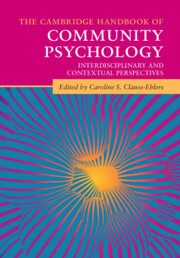Book contents
- The Cambridge Handbook of Community Psychology
- The Cambridge Handbook of Community Psychology
- Copyright page
- Dedication
- Contents
- Figures
- Tables
- Contributors
- Foreword
- Part I Foundational Concepts
- Part II Research, Assessment, and Program Evaluation
- Part III Community Psychology in Action
- 10 Women and Leadership
- 11 Community Resilience
- 12 Building Community Resilience and Supporting Disaster Risk Reduction through Social Action Efforts
- 13 The Consumer Recovery Movement in the United States
- 14 Taking Back the Streets
- 15 Promoting Adolescent Mental Health
- 16 Gowanus Canal and Public Policy
- 17 Family Support Services at Ronald McDonald House Promotes Healing of Seriously Ill Children
- 18 Community Psychology and a Fresh Look at Faith Healing Camps
- 19 Community Impact of Social Media
- 20 Supporting Communities through Educational Access
- 21 Psychological Impact of Climate Change on Communities
- 22 Optimal Local Government and Public Service Provision
- 23 A Public Health Approach to Delinquency and Incarceration
- 24 Public Service Organizations and Community Empowerment
- 25 Women and Immigration
- 26 Community-Based Transition Interventions for Adolescents and Young Adults with Neurodevelopmental Disabilities
- 27 Mental Health on College Campuses
- 28 LGBTQ+ Communities
- Part IV Where Do We Go from Here?
- Index
- References
23 - A Public Health Approach to Delinquency and Incarceration
A Case Study
from Part III - Community Psychology in Action
Published online by Cambridge University Press: 16 December 2021
- The Cambridge Handbook of Community Psychology
- The Cambridge Handbook of Community Psychology
- Copyright page
- Dedication
- Contents
- Figures
- Tables
- Contributors
- Foreword
- Part I Foundational Concepts
- Part II Research, Assessment, and Program Evaluation
- Part III Community Psychology in Action
- 10 Women and Leadership
- 11 Community Resilience
- 12 Building Community Resilience and Supporting Disaster Risk Reduction through Social Action Efforts
- 13 The Consumer Recovery Movement in the United States
- 14 Taking Back the Streets
- 15 Promoting Adolescent Mental Health
- 16 Gowanus Canal and Public Policy
- 17 Family Support Services at Ronald McDonald House Promotes Healing of Seriously Ill Children
- 18 Community Psychology and a Fresh Look at Faith Healing Camps
- 19 Community Impact of Social Media
- 20 Supporting Communities through Educational Access
- 21 Psychological Impact of Climate Change on Communities
- 22 Optimal Local Government and Public Service Provision
- 23 A Public Health Approach to Delinquency and Incarceration
- 24 Public Service Organizations and Community Empowerment
- 25 Women and Immigration
- 26 Community-Based Transition Interventions for Adolescents and Young Adults with Neurodevelopmental Disabilities
- 27 Mental Health on College Campuses
- 28 LGBTQ+ Communities
- Part IV Where Do We Go from Here?
- Index
- References
Summary
We explore the prevalence of delinquency and incarceration from a global, contextual perspective and review risk factors identified in the literature, as well as prevention efforts from a public health approach. As the correlation between disadvantage and delinquency is well-established, we propose that formulating this issue as one of public health provides the opportunity for both systemic and individual intervention. The relationship between disadvantage, delinquency, and adult imprisonment will be shown to be a global trend. As a public health issue, the opportunity for both systemic change and earlier individual prevention strategies arises. The absence of these community-based diversionary approaches places pressure on correctional facilities to provide these default community services. Given this, the worldwide trend for recidivism is the outcome of a predictable cyclical failure to meet this community public health need. As such, communities must recognize that current prison service designs fulfill this public health function. Their function is to separate offenders from the community, but remain connected to the community. The tragedy of the incarcerated individuals' experience is shown with a US case example demonstrating the manifestation of this complexity within an overburdened system. Implications for interdisciplinary efforts between public health and community psychology are discussed.
- Type
- Chapter
- Information
- The Cambridge Handbook of Community PsychologyInterdisciplinary and Contextual Perspectives, pp. 468 - 494Publisher: Cambridge University PressPrint publication year: 2021



